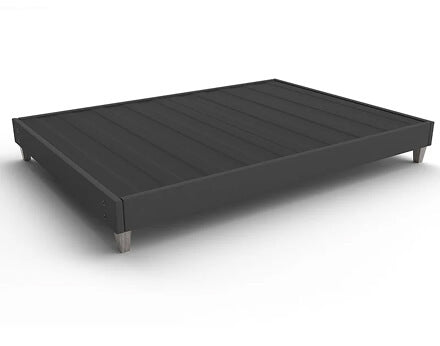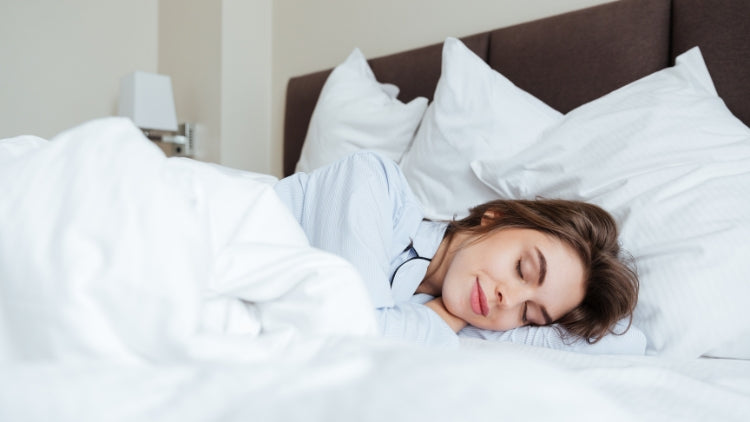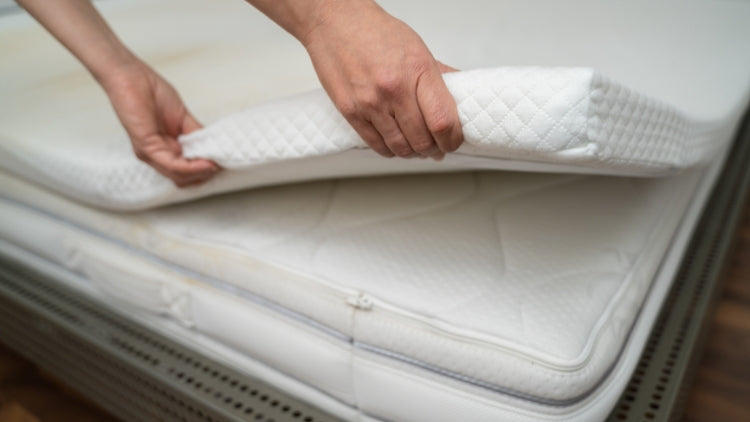Did you know that about 74% of people worldwide prefer sleeping on their sides? Many tend to lean towards this position as we age because our spines become less flexible. Knowing the right way to sleep on your side can significantly affect how well you rest.
Search for one that maintains proper spine alignment and reduces hip pressure, enhancing sleep quality and ensuring you wake up feeling rejuvenated.
What Is Side Sleeping?
A side sleeper usually falls asleep lying on their side and prefers this position. Although they often switch sides at night, they find sleeping on either their right or left side most comfortable.
Side sleepers often use a pillow between their knees to keep their hips aligned and might also place a pillow between their head and shoulders. Using pillows can help prevent discomfort from sleeping in the wrong position.
What Are the Benefits of Sleeping on Your Side?
Different sleeping positions have advantages and disadvantages, meaning the best way to sleep depends on your body, health, and what feels comfortable for you. Here are some advantages and situations where sleeping on your side might be the best choice.
Relief From Back Pain
Many people have ongoing pain, especially in their lower back. Sleeping on your stomach might put extra pressure on your spine and cause discomfort when you wake up, but switching to sleeping on your side can often help relieve back pain.
A Healthier Pregnancy
During pregnancy, doctors usually recommend sleeping on your side, especially the left side, to improve circulation for you and your baby while reducing pressure on your body. However, research shows that sleeping primarily on your right side or back in early to mid-pregnancy doesn't cause more problems. It's essential to ask your doctor for personalized advice on your sleeping position during pregnancy, but generally, sleeping on either side is safe, while sleeping on your back is best avoided later in pregnancy.
Better Gut Health
How you lie down can affect how well your digestion works. When you're on your back, gas doesn't move out of your system as fast. If you have heartburn, constipation, bloating, or other stomach problems, sleeping on your side might make you feel better.
Less Likely to Snore
Sleeping on your back can make you snore more. Your tongue may slide back towards your throat, causing an obstruction and leading to snoring. When you sleep on your side, your airway stays more open, making breathing easier. That's why doctors suggest people with sleep apnea, a severe breathing disorder during sleep, sleep on their side to help ease symptoms.
Better Brain Health
Your brain cleans out waste while you sleep, mostly at night. Researchers found that sleeping on your side helps your brain eliminate waste faster than sleeping on your stomach or back.
Tips for Side Sleeping
When sleeping on your side, try these tips to make the most of this position for better sleep.
Choose a Mattress that Supports Side Sleeping
If your mattress helps you sleep well and wake up refreshed, it's a good choice. People have different preferences, but medium-firm mattresses are usually best for side sleepers. Too soft mattresses can make your hips or shoulders sink too much, causing aches. And if the mattress is too firm, it might not give enough support, leading to discomfort. Medium-firm mattresses balance support and comfort, helping you sleep better. Many companies offer trial periods to test the mattress at home and see if it suits you.
Use a Pillow Made for Side Sleepers
The right pillow for side sleepers maintains neck and spine alignment. Avoid feather pillows and opt for a supportive latex or bamboo pillow if you always wake up with neck pain. To find a pillow with the ideal height, measure the distance between your neck and shoulder. Additionally, for extra comfort and to maintain hip alignment, consider placing a pillow between your knees, which can help minimize strain on your lower back. Using extra pillows like these ensures better posture and comfort throughout the night.
Lie in a Balanced Side Sleeping Position
When you sleep on your side, try to keep your body balanced. Here's how:
- Lie on your side with your head on the pillow.
- Make sure your neck and chin are in line with your shoulders, and your shoulders are in line with your hips.
- Keep your head straight, not tilting down or to the side.
- Keep your arms and hands straight, either by your sides or a little before you.
- Use a small pillow between your knees to ease pressure on your hips and prevent them from touching.
- Some people like to curl up in a fetal position with their legs bent, which can help relieve back pressure but don't curl up too tight, or breathing might be challenging.
- If pregnant, pillows under your belly and between your legs can help. A firm pillow or rolled-up blanket on your lower back can also lessen discomfort.
Best Side Sleeping Positions
How you choose to sleep on your side depends on what feels best for you. No matter your preference, pick a mattress that supports your spine and eases pressure on your hips and shoulders.
A common way to sleep on your side is with your knees bent and slightly extended past your body. But there are about five variations of the side sleeper position you can try out.
Fetal
In the fetal position, sleepers curl up with their knees bent close to their chests, sometimes using their arms to hold their knees. While this position can feel cozy, some sleepers might experience muscle strain and discomfort over time due to the curvature of their spines.
Log
Sleeping in the log position involves lying fairly straight with your arms at your sides, which might cause knee discomfort, which you can lessen by placing a pillow between your legs.
Lying like a log can also make your arm feel numb. To avoid this, try changing positions at night or adjusting your position to reduce pressure on your arm.
Hugger
You might be a hugger if you enjoy holding onto pillows, blankets, or your partner at night. Huggers often keep a pillow close to their chests and wrap their legs around it.
The perfect pillow for huggers can depend on personal preference. A pillow with adjustable firmness is excellent for customizing its height and thickness.
Yearner
People who sleep as yearners often spread out more than those in other positions. They stretch their arms before them and sometimes spread their legs, too.
Prayer
Many people with neck pain favor the prayer position. It involves putting your hands together and placing them under your head or pillow to raise your head and lessen neck pressure. You can also straighten or bend your legs, choosing whichever feels more comfortable for you.
What Are the Risks of Side Sleeping?
Sleeping on your side may raise your chances of experiencing shoulder pain, especially for those with existing shoulder injuries. Charles A. Su, MD, PhD, an orthopedic sports medicine surgeon at the University of Virginia Health System, explains that spending seven or more hours with pressure on one shoulder can cause pain, stiffness, or soreness.
In some cases, side sleeping might:
Make Acid Reflux and Heartburn Worse
Sleeping on your right side could lead to more heartburn or acid reflux due to your digestive system's position. However, this varies from person to person, so if you don't have any issues, you can still enjoy the benefits of side sleeping by lying on your right.
Strain the Heart More
People with heart conditions like congenital heart failure may feel pain, discomfort, and breathing problems when sleeping on their left side. Sleeping on the right side might be more comfortable for those with heart issues.
Increase Facial Irritation
Side sleepers often experience more facial irritation, breakouts, and a higher chance of premature wrinkles because they press their faces into the pillow. Regularly washing your pillowcases can reduce these effects.
Cause Arm or Shoulder Pain or Numbness
Depending on how you position your arms and shoulders while sleeping on your side and the support of your mattress, you may experience discomfort, numbness, or pain. Improving your sleep posture and using supportive pillows can help relieve these issues.
Who Should Avoid Side Sleeping on Either Side
Side sleeping is usually the best position for most people, but it can sometimes lead to shoulder pain. Dr. Charles A. Su, a surgeon, explains that keeping pressure on the shoulder while sleeping on the side can cause pain or stiffness, especially for those with shoulder issues. If you have shoulder pain, try sleeping on your back instead. If that's impossible, using pillows to support your shoulder and arm while sleeping on your side can help. Don't sleep with your arm under a pillow or above your head to prevent more shoulder pain.
FAQs
How can I improve my side sleeping position?
To enhance your side sleeping position, opt for a supportive mattress and a pillow specifically designed for side sleepers to maintain neck and spine alignment. Additionally, try lying in a balanced side sleeping position with your head, neck, shoulders, and hips aligned.
How can I prevent shoulder pain from side sleeping?
To prevent shoulder pain during sleep, ensure your mattress offers enough support, and choose a pillow that maintains proper neck and spine alignment. If you have shoulder injuries, avoid sleeping on the injured side.
Should I see a doctor if I experience shoulder pain from side sleeping?
If you consistently experience shoulder pain from side sleeping that affects your daily activities or quality of sleep, it's advisable to consult a doctor. They can assess your shoulder condition and recommend appropriate treatment or adjustments to your sleeping habits.


















Leave a comment
This site is protected by hCaptcha and the hCaptcha Privacy Policy and Terms of Service apply.